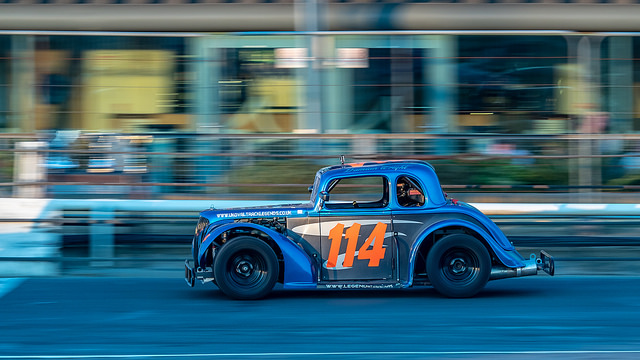It’s been a few months now since I bought my Olympus EM1 Mk2 and I’ve been to 9 events for the Oval Track Legends formula in that time. When I bought the camera I knew the downside of the micro 4/3rds sensor format would be low light situations, but of those 9 events the first 8 have been day time events, so light was not an issue. Indeed, at one event, Yarmouth in July, the light was glorious and I was able to capture some stunning photos, like this one:

This was taken with my 40-150mm f/2.8 PRO lens with 1.4x TC (tele-converter) fitted, which reduces light by 1 stop (actual aperture on this shot was f/4.5), but crucially it was taken at base ISO (200), meaning pretty much zero “noise” added to the image. Noise is the term used to refer to the graining effect that gets incorporated into images if the camera has to compensate for lack of actual light hitting the sensor.
Here is an image taken at the most recent event, which was a night time race, and although the stadium is floodlit when the sun goes down it’s not the same as daylight and the camera had to crank up the ISO considerably:

This shot was taken at ISO 6400, 5 stops higher than base. As you can see, the image has a very noticeable graining effect, it’s really not a very good image at all.
On a camera with a larger sensor, certainly a “full-frame” camera like a pro model Canon 1Dx or a Nikon D5, ISO 6400 would not have been an issue, the graining effect would be considerably less, perhaps to the point of being irrelevant. This is where my camera falls over, that small sensor just can’t cope with poor light. It’s simple physics, the bigger the sensor the more light it captures, and photography is all about capturing light.
However, all is not lost. Taking the image into Lightroom I can tweak it quite a bit, and indeed after a few minutes playing with Lightroom’s many options (quite a lot of which I don’t understand) I was able to produce this image:

Now the noise is mostly gone, and the image looks fairly decent. Not as good as the first image, but good enough, and if, like me, you’re producing images mostly for website / social media use, “good enough” is all that’s required.
There’s no denying micro 4/3rds has it’s issues, it does not perform in low light to the same extent that full-frame does, but what the Olympus EM1 Mk2 gives me is a fairly pro-level camera (fully weather-sealed, excellent fast lenses, superb auto-focus, insane FPS) for half the cost and weight of “true” pro-sports cameras, and the price I pay for having a small sensor is a bit of noise in my images, which for the most part can be dealt with in post-processing, providing you’re not intending to display them on the side of a bus!